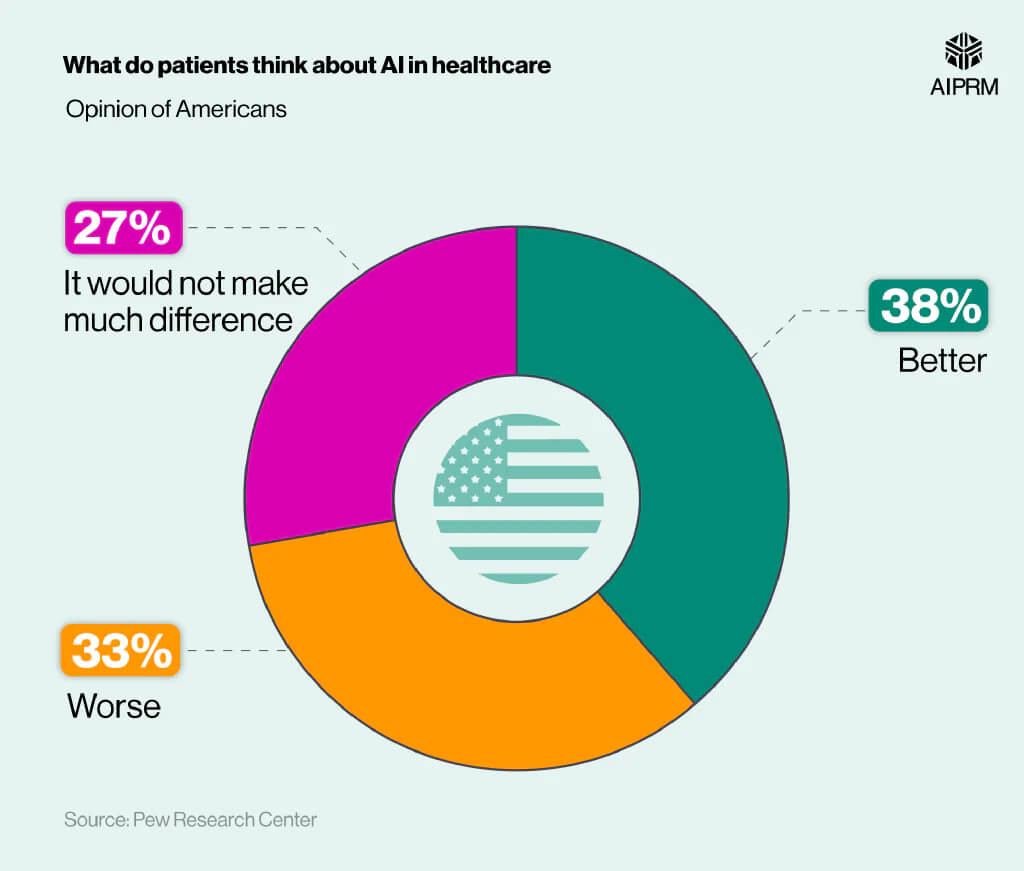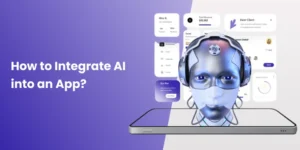AI App Development Cost for 2025 [Full Estimate]

Phrases like “Alexa, can you please play me this song?” and “Hey, Siri, turn on the light please”. And many more like this. Yes, we have entered the AI-driven era where everything is possible and so much accessible.
In today’s advanced world, AI highly influences every domain or sector, such as AI in sports. Consequently, more and more businesses are leveraging AI capabilities to simplify and automate their daily operations. Some significant industries that are executing AI into their daily tasks include information technology, healthcare, travel, education, banking, and more.
In short, AI is a paradigm shift across all industries, and its market size is anticipated to reach $826.7 billion by 2030 and twentyfold by 2025. It’s, therefore, not strange that many entrepreneurs are integrating artificial intelligence into their operations to outperform their competitors through process optimization and gain a competitive advantage.
In this write-up, we have covered all the essential aspects that bring long codes and programs to life. This comprehensive guide will help you know about the accurate cost of developing an AI-powered app in 2025. So, sit, relax, and scroll ahead to get some valuable information to plan your next AI project.
What is an AI app?
An AI app is a software or platform that uses artificial intelligence methods and algorithms to perform specific tasks or address issues. AI app development is a rising trend because these apps have the capabilities to comprehend human language, identify patterns, and make decisions from existing data.
They depend on emerging algorithms and machine-learning patterns to evaluate information and deliver intelligent responses or suggestions. AI apps serve a range of functions, including virtual assistance, speech and image recognition, and task automation.
Here are some of the best examples of AI apps you perhaps use in your regular days but are not fully aware of their functioning,
- Virtual Assistant Apps: Heading towards the digitally connected world, virtual assistant apps help people to stay organized, and productive. Most popular AI-powered apps, such as Siri or Amazon Alexa, can answer your questions or control home devices through voice commands.
- Travel and Navigation: Truly, AI in the travel and transportation sectors is gradually becoming one of the critical tools to make it ubiquitous usage of smart devices. From suggesting innovative routes to making travel arrangements to forecasting weather, AI is impressively revamping these sectors.
- Social Media Apps: We can’t imagine a single day without scrolling any of the social media apps. From real-time notifications to personalized feeds to interaction and your web searches, the role of AI has become even more important to show users accurate content.
Why is Generative AI So Significant?
Living in the connected era, generative AI has become a revolutionary technology that redefines business and industries, including media and healthcare. They can write new content, brainstorm, and thought-process to compose solutions, which can lead to significant advancements in technology.
As more companies incorporate this modern technology into their operations, it becomes useful to outline the importance associated with it. Here is why generative AI is crucial to the future of both technology and society.
Improving Creativity and Innovation
Generative AI is a category of artificial intelligence where machines themselves create ideas, designs, and content. It enables organizations to enhance creativity speed and overall effectiveness of the particular business in question.
For instance, a Generative AI development company can rapidly develop highly complex AI solutions for the generation of content for digital media and marketing or product design, among other services.
Fostering Personalization in Consumer Interactions
AI systems that are created to generate data smartly will be beneficial in the sphere of creating consumer experiences that can be tailored to individual needs. Thanks to big data, AI can customize the interactions based on customer’s preferences.
Consider the Amazon Alexa skill development – custom skills powered by generative AI allow users to create personalized experiences, like personalized daily updates or tailored recommendations.
Improving Operations and Processes in Business
Generative AI helps automate and simplify challenging tasks, boosting efficiency and eliminating human error. By leveraging machine learning algorithms and with the use of enterprise AI solutions businesses can streamline their operations and make informed decisions. From financial forecasting to product suggestions to resource management and offering valuable insights to brands, AI has the potential to perform numerous tasks.
Security and Data Privacy Issues
Some concerns have been raised in recent years with data privacy and security as generative AI technologies progress. Data protection is important in the Generative AI era due to its models that can generate the output of text that includes sensitive and personal information.
Employers need to set strict measures in employment and adhere to the right ethical standards to protect their data from misuse and hacking.
Enabling New Forms of Communication
From text to speech to image and even automation, generative AI has opened up doors for people to interact with technology. By enhancing NLP and AI generative voice assistants, like Siri, Google Assistant, and Alexa, businesses can improve communication with customers, providing dedicated support and personalized interactions through AI-based apps and platforms.
Therefore, generative AI is not just a passing trend; it is a modern technology that is poised to revamp how we work, communicate, and create the world around us. Its potential is immense and as we continue to use it, the possibilities are limitless.
AI App Development Cost Factors to Consider
Developing an AI app covers multiple factors that can influence the final cost. The integration of modern technologies and features requires special expertise, and these factors can affect the overall cost. To help you understand the various factors that contribute to the price, here are five key factors to take into consideration when calculating the cost of the AI app development.
Complexity of AI Features and Functionality
The complexity of the features that you want to integrate into your AI app is one of the most significant cost drivers. An application with simple features like fundamental task automation or perhaps data processing can be less expensive, whereas highly sophisticated solutions such as AI in healthcare, possibly with predictive models or real-time patient monitoring, can prove much costlier for development.

(Source: AIPRM)
The higher the sophistication of AI functionalities, such as decision-making algorithms, multi-modal data handling, or natural language processing, the more expensive it would be to develop and integrate appropriately.
AI Model Training and Data Requirements
Training of AI models is highly dependent on the amount and quality of data needed. In the area of healthcare, massive datasets are required for machine learning-based models to make relevant predictions regarding outcomes or diseases.
The process of gathering, cleaning, and annotating data for training and creating AI models is resource-intensive and adds to the cost. Moreover, if your application needs continuous learning or updates to improve its AI models over time, it will be a little expensive in terms of data expenses.
App Platform and Integration
You also have to consider the platform you want to deploy your AI app on, as this will play an important role in determining the costs of development. The building for iOS, Android, or cross-platform serves with specific requirements of each platform.
Furthermore, integrating chatbot functionalities or integrating AI into existing infrastructure can also impact the cost. For instance, developing an AI-powered chatbot for customer service requires natural language processing capabilities, which could involve additional integration costs with your CRM or other business systems. The more platforms or systems your AI app needs to integrate with, the higher the development cost.
User Experience (UX) and Interface Design (UI)
AI applications that provide a smooth user experience usually cost more to design because of their well-designed, intuitive user interfaces. The user experience is, in fact, the key to the ability to make complex functionalities of AI accessible and user-friendly.
Whether it’s an AI-driven healthcare app that requires easy navigation for doctors or patients or an eCommerce chatbot guided through product options, high-quality UI/UX investment is necessary. A good interface, designed according to the needs of the target audience, will need more competent designers and extra time for development, adding to costs.
Maintenance and Updates
AI technology is becoming increasingly developed, and so are the requirements for updating AI applications. After launching your first AI app, updates will be necessary to keep the AI model performing at its best. These may include updating the bugs and data set, fine-tuning the AI model as well as incorporating new features as related feedback from users comes along.
For instance, an AI application used in health care will require constantly up-to-date predictive models to make the best healthy predictions based on real-time data. Support and updates over time will, therefore, be part of the cost of developing an AI app.
Understanding the growing trends and how AI is being applied in different industries should be taken into consideration in determining the cost of developing an AI app. Trends influence project complexity, but they also illustrate the uniqueness of AI in different sectors.
These are critical AI applications and trends that will drive the future of app development and shape industry innovation.
AI App Development Trends and Key Applications Across Industries
| Trend/Technology | Description | Real-world Examples |
|---|---|---|
| AI in Healthcare | AI is transforming healthcare by enabling early disease detection, predictive analytics, and personalized treatment plans. | AI-powered diagnostic tools help doctors identify conditions like cancer through image recognition. |
| Integrating Chatbots | Chatbots powered by AI provide personalized customer service, reducing operational costs while improving user experience. | Amazon Alexa skill development enables businesses to create voice-enabled services, enhancing customer interaction. |
| Natural Language Processing (NLP) | NLP allows machines to understand, interpret, and generate human language, improving human-computer interaction. | AI-based customer service chatbots use NLP to handle customer queries and provide responses in a natural, conversational manner. |
| Generative AI | Generative AI creates new content like text, images, and music, enabling creativity and innovation. | AI-generated content for marketing campaigns or product design that significantly reduces the time needed for ideation. |
| AI in Automation | AI is being used to automate repetitive tasks, improving efficiency and freeing up human resources for more strategic work. | Robotic Process Automation (RPA) powered by AI is used in financial services to process transactions and handle customer requests faster. |
From this table, you can tell how interesting AI app development trends shape diverse industries. Whether it is in healthcare, customer service, or automation, there is much to AI development that gives businesses a competitive edge going into 2025.
A Strategic Breakdown of AI App Development Cost
For AI development, the cost is quite different based on the complexity of the application. Features, functionalities, and the scope of the project all impact how much you are going to invest. To understand this better, we have categorized AI app development costs into three phases:
Basic AI App: $10,000-$25,000
A basic AI app is usually designed to perform rudimentary tasks with minimal AI functionality. Usually, these apps feature the least machine learning or AI-based functionality and are perfect for small businesses or startups looking to leverage AI technology without making a huge investment.
For instance, simple workflows such as data entry or serving basic customer support through a chatbot can be handled by using a basic AI app.
A basic AI app usually takes fewer resources in terms of data collection, model training, and integration, which puts the overall costs lower. At this point, the app will also have some simple features, such as predictive text or even rule-based decision systems. Having a development team that can work on a basic AI app will help simplify the process; the budget is smaller, but the app can still deliver AI-driven functionality of value.
Mid-Range AI App: $25,000 to $50,000
An average AI app has more complex functionality and brings more automation and intelligence compared to a basic application. These apps normally include machine learning algorithms, data analytics, or more complex NLP models. Average AI app may include: An application for customer support, for instance, containing an inbuilt AI-powered chatbot that is not only able to understand questions asked but also provides apt responses.
This mid-range price reflects the development costs for a more robust solution that requires skilled developers and more time to build. If you are looking to hire dedicated developers for such a project, it is important to choose experts who can handle the complexity of integrating advanced machine learning capabilities.
Complex AI App: More than $50,000
A complex AI application is a very sophisticated solution that involves deep learning, complex machine learning algorithms, real-time analytics, and other cutting-edge forms of AI technologies. Such applications are widely deployed in healthcare, finance, and eCommerce, among others, involving complex choices that demand large datasets.
Since the development process of such a complex AI app takes more time and is intensive, it requires working through large volumes of data, advanced AI models, and ensuring that an app will be well integrated with various systems and entities.
Furthermore, maintenance and continuous improvement are critical for these types of applications, which is reflected in their higher costs. If you’re aiming for a high-end AI solution, hiring developers with deep expertise in AI and machine learning is essential to ensure success.
AI App Development Cost by Location and Timeline
Apart from the complexity of the app, the development cost also depends on where the development team is located. Different regions are associated with different hourly rates, and the overall timeline required for completing an AI app varies depending on the location of the team.
Below is a breakdown of how location affects the development cost and timeline for AI apps.
| Location | Basic AI App | Average AI App | Complex AI App |
|---|---|---|---|
| USA | $20,000 – $25,000 | $30,000 – $45,000 | $60,000+ |
| Eastern Europe | $12,000 – $20,000 | $25,000 – $40,000 | $50,000+ |
| India | $10,000 – $15,000 | $20,000 – $35,000 | $40,000+ |
| Southeast Asia | $12,000 – $18,000 | $22,000 – $38,000 | $45,000+ |
AI app development costs depend not only on the complexity of the project but also on the location of the development team and the features you wish to incorporate. If you are planning to hire an AI/ML development company, it’s essential to choose the right team based on your budget and project requirements and to be aware of how location and project scope can impact both the cost and timeline of development.
How to Reduce AI App Development Costs?
Having an AI app is expensive, mainly when the app contains a sophisticated ML model or has several complex features. Nevertheless, there are ways that you can take to lower the cost without affecting the quality of the final product.
Here are a few practical ways to lower AI app development expenses without losing functionality or impact:
- One of the most efficient cost-cutting techniques is to opt for MVP development as It cuts down on expensive iterations and allows focusing on the core features first.
- Outsource the development to regions with lower labour costs with high-quality AI expertise. Countries like India, the region of Eastern Europe, and Southeast Asia have incredibly good developers in these regions at probably more affordable rates compared to Silicon Valley.
- Instead of building everything from scratch, take advantage of the different pre-built AI tools, libraries, and frameworks available in the market. Tools such as TensorFlow, PyTorch, and Google’s AI services can save time and resources during the development process since they are already ready-made solutions for many AI-related tasks.
- Avoid adding unnecessary features during the development process. Many AI apps become inflated with additional functionalities increasing the cost and the time to be taken in the development of an app.
- Automating the parts of testing and quality assurance can save a lot of costs. This leads to bugs being caught early, meaning fixing issues later in the process will become less expensive.
Applying these strategies will ensure that your AI app development is cost-efficient without compromising the quality of the end product.
Are You Ready to Hire a Dedicated Development Partner?
We at Guru TechnoLabs are an experienced team of developers who would be happy to help you build your AI app idea. Our expertise in the latest AI technologies guarantees our track record for delivering successful projects, and we pride ourselves on producing scalable solutions that suit your particular business requirements.
From an MVP to test the waters to a fully AI-powered application, we have what it takes to bring your vision to life. Contact us today to talk about your project and work with us to build an innovative, cost-effective solution that drives success for your business.
Frequently Asked Questions
The maintenance cost comes after the design, development, and launching phases, thus, it can vary according to the issue the company is facing and the feedback the brand has received from the end users.
AI model training expenses might vary greatly. For instance, OpenAI CEO Sam Altman claims that the training of the company's high-end AI development project, the GPT-4 model, costs more than $100 million. This demonstrates the possible magnitude of costs associated with developing complex AI models.
Yes. Instead of building two separate apps for native platforms, it would be better to go with cross-platform app development as a single codebase runs across various platforms.
















